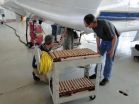(Press-News.org) VIDEO:
During this year's Atlantic hurricane season, NASA is redoubling its efforts to probe the inner workings of hurricanes and tropical storms with two unmanned Global Hawk aircraft flying over storms...
Click here for more information.
During this year's Atlantic hurricane season, NASA is redoubling its efforts to probe the inner workings of hurricanes and tropical storms with two unmanned Global Hawk aircraft flying over storms and two new space-based missions.
NASA's airborne Hurricane and Severe Storm Sentinel or HS3 mission, will revisit the Atlantic Ocean for the third year in a row. HS3 is a collaborative effort that brings together several NASA centers with federal and university partners to investigate the processes that underlie hurricane formation and intensity change in the Atlantic Ocean basin. The flights from Wallops Flight Facility in Virginia take place between Aug. 26 and Sept. 29 during the peak of the Atlantic hurricane season that runs from June 1 to Nov. 30.
"This year we're going full-force into tropical cyclone research," said Scott Braun, HS3 mission principal investigator and research meteorologist at NASA's Goddard Space Flight Center in Greenbelt, Maryland. "We'll have two Global Hawks equipped with six instruments. The new NASA-JAXA Global Precipitation Measurement (GPM) Core Observatory will be providing much higher quality data than previously available on rain structure in tropical cyclones in all ocean basins. The surface-wind monitoring ISS-RapidScat instrument to be launched to the International Space Station this season will provide valuable information on surface winds in storms."
One of the remaining mysteries that HS3 is attempting to solve is the effect of the hot, dry and dusty Saharan Air Layer (SAL) in tropical storm formation and intensification. Some research points to SAL contributing to storm formation, while other research indicates SAL suppresses it. HS3 also will investigate the role of strong thunderstorms near the core of the storms as a possible driver of intensity change.
This year NOAA, in addition to managing all of the dropsondes during the HS3 mission, will enable the mission to fly another week to better study tropical cyclones. A dropsonde is a device that measures winds, temperature and humidity, dropped from an aircraft.
The NASA Global Hawks are unmanned aircraft that will be piloted remotely from the HS3 mission control at NASA's Wallops Flight Facility. Global Hawk aircraft are well-suited for hurricane investigations because they can fly for as long as 26 hours and fly above hurricanes at altitudes greater than 55,000 feet.
One Global Hawk will carry three instruments to examine the environment around the storms, including the Scanning High-resolution Interferometer Sounder (S-HIS), the Advanced Vertical Atmospheric Profiling System (AVAPS), also known as dropsondes, and the Cloud Physics Lidar (CPL).
The second Global Hawk will focus on the inner region of the storms to measure wind and precipitation, surface winds, and atmospheric temperature and humidity. It will carry the High-Altitude Imaging Wind and Rain Airborne Profiler (HIWRAP) conically scanning Doppler radar, the Hurricane Imaging Radiometer (HIRAD), and the High-Altitude Monolithic Microwave Integrated Circuit Sounding Radiometer (HAMSR) microwave sounder.
The GPM mission, launched Feb. 27, will provide rainfall measurements every three hours around the globe, and will complement the HS3 mission. Like GPM's predecessor, the Tropical Rainfall Measuring Mission, GPM will continue to provide insights into the dynamics of a storm, such as how the storm's structure changes over the life cycle of the storm, including intensification and decay stages, and how storm intensification may depend on the presence of deep thunderstorms, known as hot towers, near the eyewall. The GPM mission will extend coverage to higher latitudes and improve scientists' ability to evaluate how storms change in intensity and structure as they move into the extra-tropics.
The ISS-RapidScat instrument, managed by NASA's Jet Propulsion Laboratory (JPL) in Pasadena, California, is slated for launch to the International Space Station in August. RapidScat will measure ocean surface winds in Earth's tropics and mid-latitudes and will provide useful data for weather forecasting of marine storms.
HS3's project management is at NASA Ames Research Center, Mountain View, California - home of the Earth Science Projects Office (ESPO). Other participating NASA centers involved in the campaign include: Goddard, the Armstrong Flight Research Center in Edwards, California, Marshall Space Flight Center in Huntsville, Alabama, and JPL.
The HS3 mission is funded by NASA Headquarters and overseen by NASA's Earth System Science Pathfinder Program at NASA's Langley Research Center in Hampton, Virginia, and is one of five large field campaigns operating under the Earth Venture program. The HS3 mission also involves collaborations with partners including the National Centers for Environmental Prediction, Naval Postgraduate School, Naval Research Laboratory, NOAA's Hurricane Research Division and Earth System Research Laboratory, Northrop Grumman Space Technology, National Center for Atmospheric Research, State University of New York at Albany, University of Maryland - Baltimore County, University of Wisconsin, and University of Utah.
NASA monitors Earth's vital signs from land, air and space with a fleet of satellites and ambitious airborne and ground-based observation campaigns. NASA develops new ways to observe and study Earth's interconnected natural systems with long-term data records and computer analysis tools to better see how our planet is changing. The agency shares this unique knowledge with the global community and works with institutions in the United States and around the world that contribute to understanding and protecting our home planet.
INFORMATION:
For more information about NASA's Earth science activities in 2014, visit: http://www.nasa.gov/earthrightnow
Related Links:
HS3 Mission - http://www.nasa.gov/hs3
NASA Hurricane Research - http://www.nasa.gov/hurricane
NASA's Airborne Science Program - http://airbornescience.nasa.gov
GPM Mission - http://www.nasa.gov/gpm
Rapidscat - https://winds.jpl.nasa.gov/missions/RapidScat/
GPM Flickr photos - https://www.flickr.com/photos/gsfc/10860068536/in/set-72157637675525645
Globalhawk montage photos - http://www.nasa.gov/content/goddard/nasas-2013-hs3-mission-global-hawk-heads-home/#.U3ESg4WPMhU
What is NASA's HS3 Mission? video - https://espo.nasa.gov/missions/hs3/content/HS3_Mission_Overview
NASA widens 2014 hurricane research mission
2014-05-29
ELSE PRESS RELEASES FROM THIS DATE:
Mechanisms of ibrutinib resistance identified in chronic lymphocytic leukemia
2014-05-29
COLUMBUS, Ohio – A new study has discovered how resistance develops in patients taking ibrutinib, a new and highly effective drug for the treatment of chronic lymphocytic leukemia (CLL).
The study was published in the New England Journal of Medicine and led by researchers at The Ohio State University Comprehensive Cancer Center – Arthur G. James Cancer Hospital and Richard J. Solove Research Institute (OSUCCC – James). It identifies gene mutations that cause ibrutinib resistance in CLL patients.
"Knowledge of these mutations is the first step in the development of ...
New tools help protect world's threatened species
2014-05-29
Athens, Ga. – New tools to collect and share information could help stem the loss of the world's threatened species, according to a paper published today in the journal Science. The study—by an international team of scientists that included John L. Gittleman, dean of the University of Georgia Odum School of Ecology—was led by Stuart L. Pimm of Duke University and Clinton N. Jenkins of the Instituto de Pesquisas Ecológicas in Brazil.
"As databases coalesce and policymakers have access to greater information, we see real and improving successes for conservation science," ...
Two GOES-R instruments complete spacecraft integration
2014-05-29
VIDEO:
In addition to monitoring weather on Earth, the GOES-R satellites will monitor weather in space caused by electromagnetic radiation and charged particles released from solar storms on the Sun. Many...
Click here for more information.
Two of the six instruments that will fly on NOAA's first Geostationary Operational Environmental Satellite - R (GOES-R) satellite have completed integration with the spacecraft. The Solar Ultraviolet Imager (SUVI) and Extreme Ultraviolet and ...
New report details more geoscience job opportunities than students
2014-05-29
Alexandria, Va. – In the American Geosciences Institute's newest Status of the Geoscience Workforce Report, released May 2014, jobs requiring training in the geosciences continue to be lucrative and in-demand. Even with increased enrollment and graduation from geoscience programs, the data still project a shortage of around 135,000 geoscientists needed in the workforce by the end of the decade.
"Industry has recognized, and is mitigating the upcoming shortage of skilled geoscientists in their employ, but the federal geoscience workforce is still demonstrably shrinking" ...
Study: Baltimore hookah bars contain elevated levels of carbon dioxide and air nicotine
2014-05-29
Smoking waterpipes, or hookahs, creates hazardous concentrations of indoor air pollution and poses increased risk from diminished air quality for both employees and patrons of waterpipe bars, according to a new study from the Institute for Global Tobacco Control at the Johns Hopkins Bloomberg School of Public Health. In an analysis of air quality in seven Baltimore waterpipe bars, researchers found that airborne particulate matter and carbon monoxide exceeded concentrations previously measured in public places that allowed cigarette smoking and that air nicotine was markedly ...
PCOS diagnosis tied to inflammation during pregnancy
2014-05-29
Washington, DC—Women who have polycystic ovary syndrome – the most common hormone disorder in women of reproductive age – are more likely to experience chronic low-grade inflammation during pregnancy than counterparts who do not have the condition, according to a new study published in the Endocrine Society's Journal of Clinical Endocrinology & Metabolism (JCEM).
Polycystic ovary syndrome, or PCOS, is a leading cause of infertility. Symptoms can include irregular or absent menstrual periods, infertility, weight gain, acne, excess hair on the face and body, or thinning ...
Study finds mode of transportation affects how we feel
2014-05-29
What mode of transportation makes you happiest?
Clemson researchers investigated how emotions like happiness, pain, stress, sadness and fatigue vary during travel and by travel mode in a new study published in the journal Transportation.
Utilizing data from the American Time Use Survey, collected by the Bureau of Labor Statistics, the researchers were able to determine the average mood felt by people during different types of travel.
"We found that people are in the best mood while they are bicycling compared to any other mode of transportation," said Eric Morris, ...
Study: New genes identified may unlock mystery of keloid development
2014-05-29
DETROIT – Researchers at Henry Ford Hospital in Detroit have uncovered previously unidentified genes that may be responsible for keloid scarring, a discovery that could unlock the mystery of keloid development and provide insight for more effective treatment.
"Much of the uncertainty surrounding keloids is rooted in there being no known cause for their development," says study lead author Lamont R. Jones, M.D., vice chair, Department of Otolaryngology-Head and Neck Surgery at Henry Ford.
"But it is believed that keloids have a genetic component given the correlation ...
How breast cancer 'expresses itself'
2014-05-29
About one in eight women in the United States will contract breast cancer in her lifetime. Now new research from Tel Aviv University-affiliated researchers, in collaboration with Johns Hopkins University, has provided another tool to help women, clinicians, and scientists searching for a cure to the one of the most widespread yet incurable diseases on the planet.
Dr. Ella Evron and Dr. Ayelet Avraham of the TAU-affiliated Assaf Harofeh Medical Center, together with Prof. Saraswati Sukumar of Johns Hopkins, have found that "gene regulation," the process that shuts off ...
Cloud formation & rainfall affected by pollutant oxidation of biodiesel emissions
2014-05-29
A study into how organic molecules in the atmosphere affect cloud formation has found that a main component of biodiesel, methyl oleate, reacts with ozone surprisingly fast. This process may counterbalance the growth of water droplets resulting from emissions, which would in turn inhibit cloud formation and therefore affect the water cycle in a highly complex way.
The research, published in the journal Physical Chemistry Chemical Physics, was performed by an international team of scientists working at the ILL (Institut Laue-Langevin) in Grenoble, France.
Methyl oleate ...





